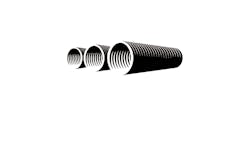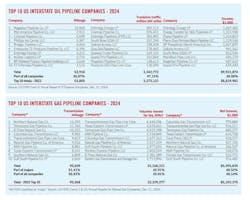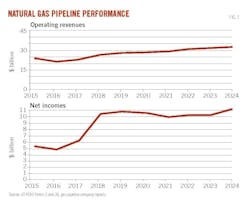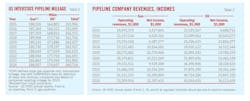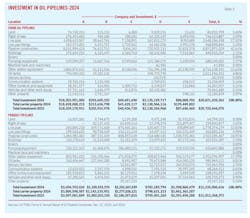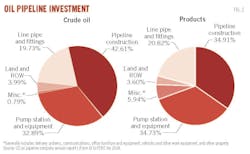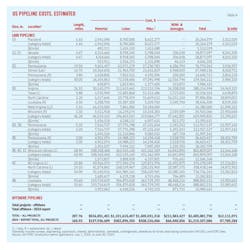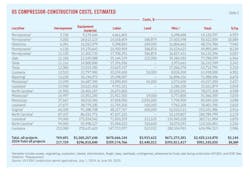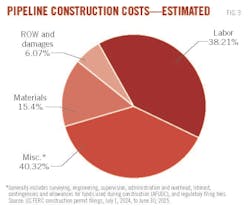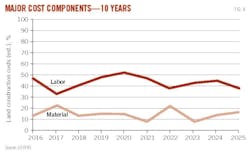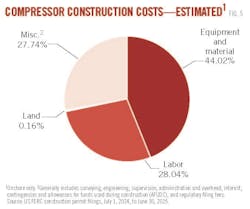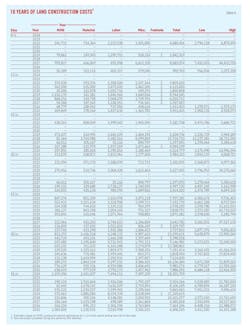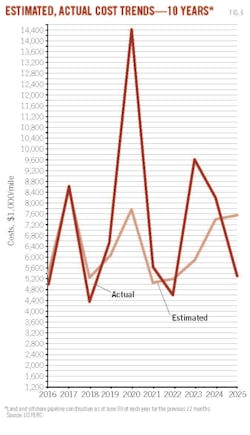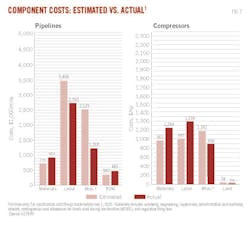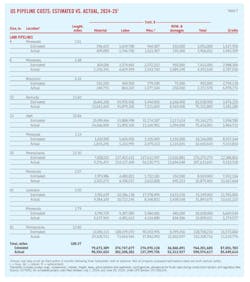Pipeline construction costs reach record $12.1 million/mile
Sharply higher costs in all categories—particularly material, which roughly doubled—increased the estimated price of building land pipelines by about $4.5 million/mile, to a record $12.1 million/mile. Estimated miscellaneous costs increased by almost two-thirds, about $1.8 million/mile, and labor costs also rose, by nearly $1.2 million/mile.
“Contingencies” are the most variable of the costs included as miscellaneous, with the amount set aside for such purposes typically reflecting changes in market uncertainty. Expected right-of-way costs were 88% higher this year than last.
US oil and natural gas pipeline operators’ net incomes also pushed into record territory. Gas pipeline earnings rose 8.75% to mark a third straight year of gains after 2 years in a row of decline and reached a record $11.2 billion, eclipsing the $10.8 billion earned in 2019 (Fig. 1).
Oil pipeline operators’ net incomes, meanwhile, maintained rapid growth in 2024. reaching a new all-time high of $26.1 billion. The 14% increase in liquids pipelines’ earnings was the segment’s third double-digit increase in a row.
Liquids pipeline companies used this money at least in part to increase new investment in carrier property, bumping this spending category by 30% in 2024. Additions to gas plants meanwhile increased 169% as demand for both power generation and liquefaction surged.
Details
Oil pipeline earnings as a percent of revenue continued to improve, nearing the 60.13% level reached in 2019. Natural gas pipeline operators’ net incomes as a share of revenue edged slightly higher to almost 34%, continuing their climb toward the 39% level approached in 2018.
Compression construction costs ($3,144/hp) continued to slide, accompanied by a more than trebling of proposed work, to just below 770,000 hp of new projects.
Actual land pipeline construction costs for projects completed in the 12 months ending June 30, 2025, were roughly $1.6 million/mile less than estimated costs, with the largest difference seen in estimated vs. actual miscellaneous costs, which more than outstripped higher than expected material and right-of-way costs.
US pipeline data
At the end of this article, two large tables (linked) offer a variety of data regarding US oil and gas pipeline companies: revenue, income, volumes transported, miles operated, and investments in physical plants. These data are gathered from annual reports filed with FERC by regulated oil and natural gas pipeline companies for the previous calendar year.
Data are also gathered from periodic filings with FERC by those regulated natural gas pipeline companies seeking FERC approval to expand capacity. OGJ keeps a record of these filings for each 12-month period ending June 30. Combined, these data allow an analysis of the US regulated interstate pipeline system.
Annual reports. Companies that FERC classifies as involved in the interstate movement of oil or natural gas for a fee are jurisdictional to FERC, must apply to FERC for approval of transportation rates, and therefore must file a FERC annual report: Form 2 or 2A, respectively, for major or nonmajor natural gas pipelines; Form 6 for oil (crude or product) pipelines.
The distinction between “major” and “nonmajor” is defined by FERC and appears as a note at the end of the table listing all FERC-regulated natural gas pipeline companies for 2024 at the end of this article.
The deadline to file these reports each year is in April. For a variety of reasons, companies often miss that deadline and apply for extensions but eventually file an annual report. That deadline and the numerous delayed filings explain why publication of this report on pipeline economics occurs later in each year. Earlier publication would exclude many companies’ information.
Periodic reports. When a FERC-regulated natural gas pipeline company wants to modify its system, it must apply for a “certificate of public convenience and necessity.” This filing explains in detail the planned construction, justifies it, and—except in certain instances—specifies what the company estimates construction will cost.
Not all applications are approved. Not all that are approved are built. But assuming a company receives its certificate and builds its infrastructure, it must—again, with some exceptions—report back to FERC how its original cost estimates compared with what it spent.
Reporting changes
The number of companies required to file annual reports with FERC may change from year-to-year, with some companies becoming jurisdictional, others nonjurisdictional, and still others merging or being consolidated out of existence. Such changes require care be taken in comparing annual US petroleum and natural gas pipeline statistics.
Reports for 2024 show an increase in FERC-defined major gas pipeline companies: 104 of 175 compaines filing, from 99 companies of 177 for 2023.
FERC-regulated major natural gas pipeline mileage shrank in 2024 (Table 1), final data showing a decrease of 807 miles, or 0.4%. Oil mileage also fell, losing 207 miles (0.2%).
Rankings; activity
Natural gas pipeline companies in 2024 grew revenues by roughly $2 billion (6.4%), marking an eighth-straight year of growth. Net income’s growth was even stronger; up 8.75% or roughly $900 million, a third-consecutive annual increase.
Oil pipeline earnings continued the return to growth started in 2021, climbing roughly $3.3 billion (14%). Revenues rose about $2.8 billion (7%) for the second year in a row (Table 2).
Improved liquids pipeline earnings came on the back of an 11.75% increase in crude oil deliveries, product shipments actually shrinking 0.14% year-on-year.
OGJ uses the FERC annual report data to rank the Top 10 pipeline companies in three categories (miles operated, trunkline traffic, and operating income) for oil pipeline companies and three categories (miles operated, gas transported for others, and net income) for natural gas pipeline companies.
Positions in these rankings shift year to year, reflecting normal fluctuations in companies’ activities and fortunes. But also, because these companies comprise such a large portion of their respective groups, the listings provide snapshots of overall industry trends and events.
For instance, earnings for the Top 10 oil pipeline companies rose 12.5% compared with the 14% overall increase for the segment, as Top 10-company trunkline traffic fell even as overall traffic increased by roughly 6.5%.
Earnings by the Top 10 most-profitable gas pipeline companies grew by 3.9%, despite a 0.5% decrease in volumes moved for a fee, on a combination of improved efficiencies and higher shipping rates.
As noted earlier, net income as a portion of natural gas pipeline operating revenues rose to 34% in 2024, the second year in a row of increases after slipping to 32.99% in 2022. The percentage of income as operating revenues for oil pipelines approached the record of 60.13% set in 2019, reaching 59.95%. It’s the fourth consecutive annual increase after this metric collapsed to 48.53% in 2020.
Net income for major natural gas pipelines as a portion of gas-plant investment increased slightly to 4.6%. Net income as a portion of investment in oil pipeline carrier property grew to 15.9%, handily eclipsing 2019’s recent high of 14.3%.
Major and nonmajor natural gas pipelines in 2024 reported total gas-plant investment of roughly $248 billion, the highest level ever, up from $230 billion in 2023, $226 billion in 2022, $219.5 billion in 2021, and $213 billion in 2020.
Investment in oil pipeline carrier property also continued to grow in 2024, reaching nearly $164.5 billion. Carrier property in 2023 was $161 billion, up from 2022’s total of $157 billion, 2021’s $156.5 billion, and 2020’s total of $149 billion.
OGJ for many years has tracked carrier-property investment by five crude oil pipeline and five products pipeline companies chosen as representative in terms of physical systems and expenditures (Table 3).
The five crude oil pipeline companies in 2024 increased overall investment in carrier property by roughly $100 million (0.5%).
The five products pipeline companies’ overall investment in carrier property increased 2% in 2024, about $222.7 million.
Comparisons of data in Table 3 with previous years must be done with caution as reorganizations, mergers, acquisitions, and sales can make comparisons with previous years difficult.
Fig. 2 illustrates how investments in the crude oil and products pipeline companies were divided.
Construction mixed
Applications to FERC by regulated interstate natural gas pipeline companies to modify certain systems must, except in certain instances, provide estimated costs of these modifications in varying degrees of detail. Tables 4 and 5 show companies’ estimates during the period July 1, 2024, to June 30, 2025, for what it will cost to construct a pipeline or install new or additional compression.
These tables cover a variety of locations, pipeline sizes, and compressor-horsepower ratings. Not all projects proposed are approved. And not all projects approved are eventually built.
- Roughly 288 miles of pipeline were formally proposed to FERC for land construction in the 12 months ended June 30, 2025, with no offshore work submitted. The land level was the highest since roughly 367 miles were proposed in 2020; and up from the 169 miles submitted in 2024, the 110 miles submitted in 2023, 169 miles in 2022, and 77 miles submitted in 2021.
- An even bigger bounce occurred in new or additional compression proposed by the end of June 2025, which totaled a recent high of nearly 770,000 hp, up three-and-a-half times from the June 2024 total of almost 218,000 hp, itself a multiple of the 98,000 hp filed for in 2023. The 502,000 hp applied for in 2022 eclipsed 2021’s 200,000 hp but not the 680,000 hp proposed in 2020.
Putting US gas pipeline construction in perspective, Table 4 lists 18 land-pipeline “spreads,” or mileage segments, and 0 marine projects, compared with:
- 4 land and 0 marine projects (OGJ, December 2024, p. 24).
- 5 land and 0 marine projects (OGJ, Oct. 2, 2023, p. 20).
- 19 land and 0 marine projects (OGJ, Oct. 3, 2022, p. 31).
- 9 land and 0 marine projects (OGJ, Oct. 4, 2021, p. 52).
- 18 land and 0 marine projects (OGJ, Oct. 3, 2020, p. 42).
Only two spreads in 2025 measured 50 miles or more, a 48-in. OD transmission line running 55.6 miles through Louisiana and a mixed-diameter project totaling 68.9 miles in Wisconsin and Illinois.
For the 12 months ending June 30, 2025, the 18 land projects filed would cost an estimated $3.5 billion, compared with the 4 land projects filed for $1.3 billion a year earlier.
Estimated 2024-25 $/mile construction costs for new onshore projects as filed with FERC surged by roughly $4.3 million, reaching a new record of $12.1 million/mile; topping 2023-24 $/mile costs of $7.8 million and the previous record of $10.7 million/mile set in 2022-23. In 2021-22 the average cost was $8.7 million/mile. In 2020-21 it was $8.3 million/mile.
These statistics cover only FERC-regulated pipelines. Many other pipeline construction projects were announced in the 12 months ending June 30, 2025, but were outside FERC jurisdiction.
Cost components
Variations over time in the four major categories of pipeline construction costs—material, labor, miscellaneous, and right-of-way (ROW)—can reflect both more general economic and political trends and the specifics of a given place and time.
Materials can include line pipe, pipe coating, and cathodic protection.
“Miscellaneous” costs generally cover surveying, engineering, supervision, contingencies, telecommunications equipment, freight, taxes, allowances for funds used during construction (AFUDC), administration and overheads, and regulatory filing fees.
ROW costs include obtaining rights-of-way and allowing for damages.
For the 18 spreads filed in 2024-25, project cost-per-mile increased in all categories. The biggest percentage gain was in material, which roughly doubled to $1.9 million/mile, while the biggest outright gain was the $1.9 million/mile increase in miscellaneous costs to $4.9 million/mile.
In 2011, miscellaneous charges passed material to become the second most expensive cost category and in 2017 passed labor costs to become the most expensive category of all. The two categories eventually flipped again, with labor spending the past 5 years as the most expensive category before surrendering the position in this year’s report back to miscellaneous. A breakdown of 2024-25 costs shows:
- Material—$1.9 million/mile, roughly twice the $934,979/mile for 2023-24.
- Labor—$4.6 million/mile, a roughly $1.15-million/mile increase from $3.45 million for 2023-24.
- Miscellaneous—$4.9 million/mile, up about $1.9 million/mile from the roughly $3-million/mile estimated cost for 2023-24.
- ROW and damages—$735,277/mile, up from $391,002/mile in 2023-24.
Table 4 lists proposed pipelines in order of increasing size (OD) and decreasing lengths within each size.
The average cost-per-mile for the projects rarely shows clear-cut trends related to either length or geographic region. In general, however, the cost-per-mile within a given diameter decreases as the number of miles rises. Lines built nearer populated areas also tend to have higher unit costs. Additionally, road, highway, river, or channel crossings and marshy or rocky terrain each strongly affect pipeline construction costs.
Fig. 3, derived from Table 4, shows cost-component splits for pipeline construction.
Labor’s 2025 portion of estimated costs (38.2%) fell from last year’s 44.3% and remained well below the recent high of 52.4% reached in 2020.
Material costs’ portion of land pipeline costs increased from 12% in the 2024 report to 15.4%. Both are up from a low of 8.7% in 2023 but still down sharply from material’s 22.5% portion in 2022.
Fig. 4 plots a 10-year comparison of land-construction unit costs for material and labor.
Fig. 5 shows the cost split for land compressor stations based on data in Table 5.
Table 6 lists 10 years of unit land-construction costs for natural gas pipeline with OD ranging from 8 to 36 in. The table’s data consist of estimated costs filed under CP dockets with FERC, the same data shown in Tables 4 and 5.
Table 6 shows that the average cost per mile for any given diameter may fluctuate year-to-year as projects’ costs are affected by geographic location, terrain, population density, and other factors.
Completed project costs
In most instances, a natural gas pipeline company must file with FERC what it ended up spending on an approved and built project. This filing must occur within 6 months of a pipeline’s successful hydrostatic testing or a compressor’s being put in service.
Fig. 6 shows 10 years of estimated vs. actual costs on cost-per-mile bases for project totals.
Tables 7 and 8 show actual costs for pipeline and compressor projects reported completed to FERC during the 12 months ending June 30, 2025. Fig. 7, for the same period, depicts how total actual costs ($/mile) for each category compare with estimated costs.
Actual costs for pipeline construction were roughly $1.6 million/mile less than estimated costs for the same project, reversing 2 straight years in which they’d been more expensive. Material costs were actually about $174,000/mile more than estimated and ROW was also more expensive, but not by enough (even when combined) to make up for the lower actual labor and miscellaneous costs.
If a project was reported in construction spreads in its initial filing, that’s how projects are broken out in Table 7. Completed projects’ cost data, however, are typically reported to FERC for an entire filing, usually but not always separating pipeline from compressor-station (or metering site) costs and lumping various diameters together.
The 12 months ending June 30, 2025, saw almost 261,000 hp completed, up nearly 120,000 hp from the year before. Actual compression costs of $3,463/hp were less than half the $7,454/hp from the year before and just 9% higher than estimates. Actual miscellaneous and land costs were higher than project estimates, while materials and labor cost less than expected.
About the Author
Christopher E. Smith
Editor in Chief
Chris brings 32 years of experience in a variety of oil and gas industry analysis and reporting roles to his work as Editor-in-Chief, specializing for the last 20 of them in the midstream and transportation sectors.
Laura Bell-Hammer
Statistics Editor
Laura Bell-Hammer is the Statistics Editor for Oil & Gas Journal, where she has led the publication’s global data coverage and analytical reporting for more than three decades. She previously served as OGJ’s Survey Editor and had contributed to Oil & Gas Financial Journal before publication ceased in 2017. Before joining OGJ, she developed her industry foundation at Vintage Petroleum in Tulsa. Laura is a graduate of Oklahoma State University with a Bachelor of Science in Business Administration.
